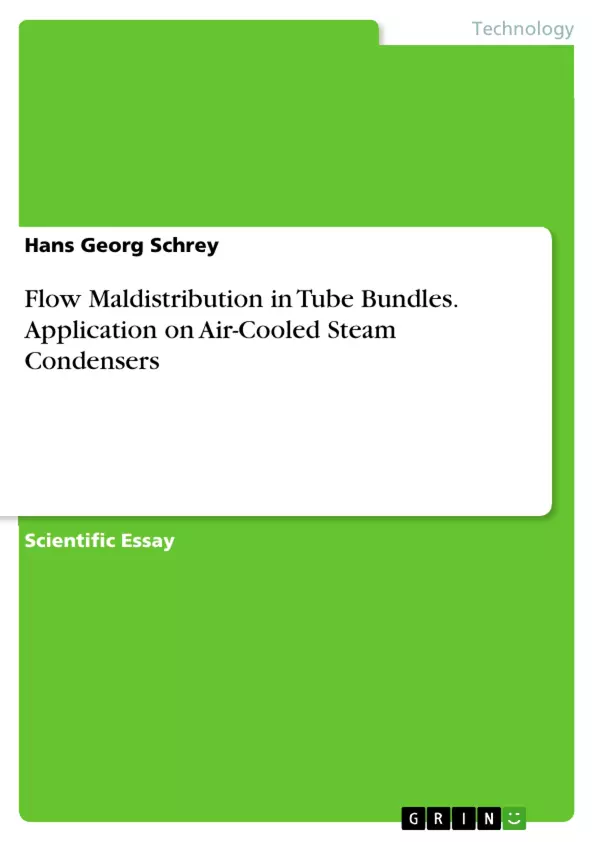Tube bundles are standard equipment in heat exchanger design. Typically, when passing the bundle the process flow is subject to several flow re-directions which in consequence, lead to an uneven process side flow profile in parallel tubes. This may be harmless if speed differences are on a low scale. If, however a certain level of maldistribution is exceeded the operator may be confronted with severe consequences.
Orifice design to ensure even flow rates in pre-heater applications are well-known in boiler design. Specific equations to assess maldistribution and to design orifices in different flow arrangements have been developed for that purpose.
Less attention so far, has been paid to the field of air-cooled steam condensers (“ACCs”) although, occasionally some plants encounter problems of steam side maldistribution. This is visible by excessive sub-cooling of border areas (“cold spot” formation) at some condenser bundles caused by premature termination of steam condensation. As a result, the plant performance is badly affected. Moreover, in cold climates these cold spots are a potential risk of frost formation which must be definitely prevented.
Well-known calculation procedures of maldistribution will be summarized in PART ONE of this report by creating a unified theory applicable to all types of flow arrangement (single-phase) based on matrix algebra. It is shown how this method can be successfully applied to geometry variations.
In PART TWO, the procedure is extended to flow maldistribution of condensing steam in a typical ACC street (two-phase). The basics physics are diligently explained. The procedure enables proper design of ducting geometry. Conclusions for safe everyday operation – especially at variation of ambient conditions - are drawn.
Inhaltsverzeichnis (Table of Contents)
- Introduction
- PART ONE
- Tube Bundle Model
- Flow Maldistribution in Single Phase Flow
- PART TWO
- Two-Phase Flow in ACC Streets
- Conclusions
Zielsetzung und Themenschwerpunkte (Objectives and Key Themes)
This report explores the phenomenon of flow maldistribution in tube bundles, focusing specifically on its impact on air-cooled steam condensers (ACCs). The objective is to develop a unified calculation model for both single-phase and two-phase flow, allowing for accurate prediction and mitigation of maldistribution effects. This understanding is crucial for optimizing ACC design and operation, ensuring efficient heat transfer and preventing detrimental effects such as cold spot formation and condensate freezing.
- Flow Maldistribution in Tube Bundles
- Single-Phase Flow
- Two-Phase Condensing Steam Flow
- Air-Cooled Steam Condensers (ACCs)
- Cold Spot Formation and Mitigation
Zusammenfassung der Kapitel (Chapter Summaries)
- Introduction: This chapter introduces the problem of flow maldistribution in tube bundles and its significance in heat exchanger design, particularly in ACCs. It highlights the need for a comprehensive model to address two-phase flow conditions.
- Tube Bundle Model: This chapter presents an idealized model of a tube bundle, simplifying its geometry for mathematical analysis. It introduces key parameters like flow areas, area ratios, and pressure drops.
- Flow Maldistribution in Single Phase Flow: This chapter develops a unified calculation model for single-phase flow maldistribution in tube bundles, employing matrix algebra and considering various flow arrangements.
Schlüsselwörter (Keywords)
This report focuses on flow maldistribution in tube bundles, specifically addressing single-phase and two-phase flow conditions. Key topics include air-cooled steam condensers (ACCs), cold spot formation, and the development of a unified calculation model for predicting and mitigating maldistribution effects. This work contributes to the understanding and optimization of ACC design and operation, ensuring efficient heat transfer and preventing detrimental consequences.
- Arbeit zitieren
- Dipl.-Ing. Hans Georg Schrey (Autor:in), 2018, Flow Maldistribution in Tube Bundles. Application on Air-Cooled Steam Condensers, München, GRIN Verlag, https://www.hausarbeiten.de/document/432886


